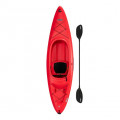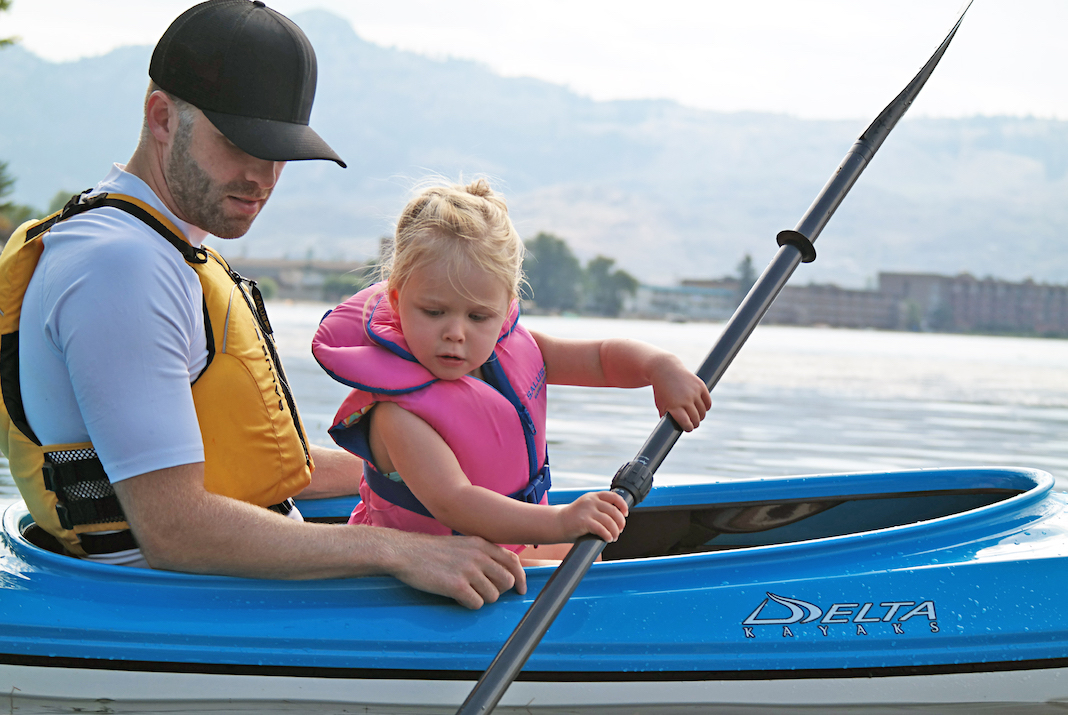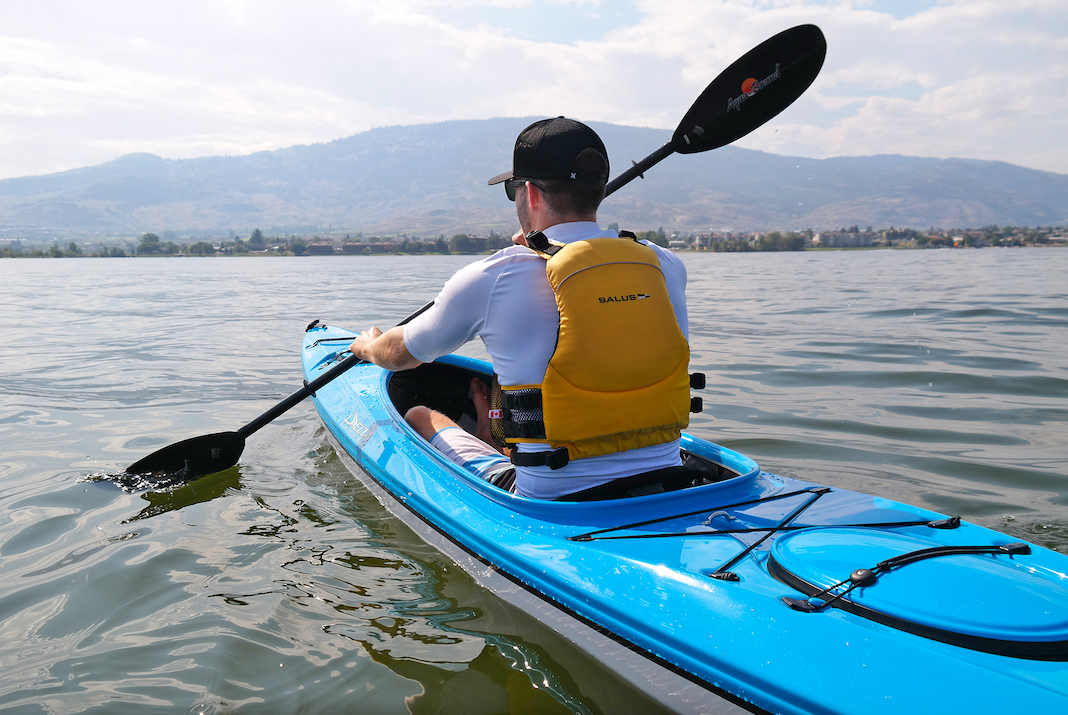Recreational kayaks are often referred to as “lake kayaks” and not without reason: buyers interested in the broad category of recreational kayaks are often looking for the best kayaks for lake use. However, the term recreational kayak is just as applicable to users wishing for a comfortable craft to explore quiet rivers or sheltered tidal waters—as well as those searching for a crossover kayak that’s just as effective as a lake kayak as it is a fishing kayak (often with a few easy modifications). In the end, recreational kayaks may be best defined by their ultimate versatility.
With so much potential, it’s no surprise that recreational kayaks comprise the largest segment of paddlesports. Finding the best recreational kayak can be overwhelming. But your search can be narrowed by considering your specific needs and wants, most of which relate to intended uses (casual cottage use, day tripping on sheltered waterways, kayak fishing) and what you want to get out of kayaking in the future (is casual paddling enough or are you looking to improve your skills?). The choices are different if you will be paddling in warm or cold water.
The question, What is the best lake kayak? is clearly a complicated one…and we’re here to help! Our Paddling Buyer’s Guide lists every recreational kayak on the market, including specs, prices, reviews and where to buy. This overview of the best lake kayaks covers what’s available and where to find it. It also provides answers to all your most pressing questions about finding the best recreational kayak for your needs.
Shop for recreational kayaks
There’s no need to feel intimidated by all the choices, options and places to buy a recreational kayak. Follow the links below to discover what’s best for you based on your paddling goals. Links will take you to our comprehensive Paddling Buyer’s Guide, where you’ll find every recreational kayak on the market, including specs, prices, reviews and retail outlets.
Top picks: Best recreational kayaks for 2025
The following rec kayaks have received the highest star ratings by reviewers in our Paddling Buyer’s Guide. See and review all recreational kayaks here.
Best Recreational Kayaks

Chelan 120

BKC RA220 Sit On Top Angler Kayak
Shopping for a used recreational kayak?
Depending on where you’re located, the used market is often flooded with high-quality recreational kayaks available for a fraction of the cost of a new boat. Of course, finding a used recreational kayak that’s solidly built and meets all your needs takes some homework.
Your first step is to research the specific attributes of the make and model of kayak you’re considering; our Paddling Buyer’s Guide is a great place to start. Once you’ve narrowed down your selection to a short list, heed the following advice to make a good purchase:
Overall condition
First impressions matter—especially in terms of the overall condition of the kayak. Take note of any fading due to excessive sun exposure and apply firm pressure to the bottom of the hull to test for stiffness (it shouldn’t feel soft). Examine the top and bottom of the hull for deep gouges (more than 3 mm or 1/8th of an inch deep); obvious abrasion or discoloration; and deformities, which will make the kayak paddle less efficiently.
Most recreational kayaks are plastic, and so extremely durable and able to withstand plenty of abuse. Some damage is fine and probably only cosmetic, so long as the shape of the kayak remains intact.
Outfitting
Outfitting is the critical interface between the paddler and kayak, including the seat, back support, thigh rests and footrests. Examine each of these parts individually and consider how well they work together as a whole—the easiest way to gauge this is by sitting in the boat (and ideally paddling it) to make sure it feels comfortable.
Outfitting often comes down to personal preference; there’s no one-size-fits-all. A supportive and padded seat is obvious; test the operation of the kayak’s footrests (which often get jammed with sand and grit) and back support, both of which are essential for more efficient and ergonomic paddling.
One of the drawbacks of a bargain-priced kayak is substandard outfitting. Take a close look and consider investing in a more expensive kayak if you plan on more serious paddling. If you’re handy, outfitting is easily modified with some glue, foam and DIY time; consider any upgrades you could make to save a few bucks and get a custom fit.
Accessories are often the distinguishing factor between fishing kayaks and general purpose recreational kayaks; if you want to do some kayak angling make sure you examine features like rod holders and live wells.
On the water
The only way to truly appreciate the comfort and performance of a kayak is to try it before committing to a purchase. Arrange a meeting place with the seller that allows you to take a few moments on the water. Bring your usual paddle and dress in what you plan to wear while paddling.
Make a deal
In general, the typical starting point for a used kayak in moderate condition was about half its retail price. All that’s changed in the wake of boat shortages brought on by the pandemic and the related premium on outdoor equipment, but you can use it as a starting point in haggling for a price.
Add some accessories
Ask the seller if they’re willing to throw in a paddle, sprayskirt or PFD (make sure it’s in good shape, fits properly and is Coast Guard-approved for the location you’ll be paddling). Or, maybe you can save a few dollars and opt out of a package deal if you have your own paddling gear.
For more tips on what to look for when selecting a used kayak, read our article on How To Buy A Used Kayak.
Recreational kayak buying guide

With so many boats available to choose from, it’s easy to become overwhelmed by questions when buying a recreational kayak. Narrow your search by targeting the style of kayaking (family, day touring, fishing) that’s most appealing. Then, try as many different models as possible before making a purchase. You may be able to borrow the kayaks of friends to get a sense of what’s available and how different design elements fit your body and perform on the water.
Another recommendation is to shop at paddling and outdoor specialty stores, which offer far more expertise and a better selection of high-quality kayaks than generic big box outlets. Lastly, try to favor retailers that provide the option of test-paddling kayaks before you buy.
Here are expert answers to some of the most common questions from beginner kayak buyers.
-
What is a recreational kayak?
A recreational kayak is often defined by its intended use and general shape and dimensions. Recreational kayaks are meant to be used on sheltered water with minimal exposure to wind and waves. They’re typically under 12 feet in length for singles (up to 14 feet for tandems) and often relatively wide—24 to 32 inches, depending on whether they are single or tandem. These features make recreational kayaks extremely stable for beginners and easy to handle, but with less glide, performance and safety in rough water than a longer, sleeker, more seaworthy sea kayak.
Another way of identifying a recreational kayak is whether or not it features bulkheads—watertight compartments that allow the kayak to float even when it’s partially flooded with water, which enables paddlers to keep cargo dry on longer trips and also allows for deep-water kayak-over-kayak rescues in groups. Recreational kayaks often have only one bulkhead or else lack them altogether, an important factor that reduces their overall seaworthiness. It’s important to recognize this shortcoming when shopping for a recreational kayak.
-
Difference between fishing kayaks and recreational kayaks
The general hull shape of fishing kayaks and recreational kayaks are often identical; in fact, many of the most popular fishing kayaks are simply recreational kayaks with certain upgrades to on-board accessories and outfitting. Fishing kayaks are sold with angling-specific features like rod holders, live wells and convenient places to store tackle, fish finders and other gear. Recreational kayaks, on the other hand, lack these add ons.
If you’re handy and want to develop a custom fishing kayak it’s often possible to make modifications to a standard recreational kayak; this DIY option is a great way to save money and personalize your kayak.
-
Recreational kayaks vs sea kayaks
Sea kayaks are meant for more advanced paddling—both in terms of the environment and paddler skill. They’re longer and sleeker (usually starting at 14 feet in length and under 25 inches wide) and more efficient to paddle longer distances. Compared to recreational kayaks, sea kayaks are more appropriate for use in wind and waves—in the hands of a trained and experienced paddler.
Sea kayaks feature decks and cockpits that are meant to be used with a sprayskirt for additional protection from the elements. Most importantly, sea kayaks feature watertight bulkheads (unlike many recreational kayaks), which enable groups of trained paddlers to perform rescues to quickly respond to capsizes in open water. Sea kayaks are far more expensive than recreational kayaks (double the cost or more) and are often expertly designed for specific applications, such as overnight kayak camping trips, rough water paddling or traditional Greenland-style kayaking. Take a close look at a sea kayak if you want to develop your skills and want to explore exposed coastlines.
-
Ocean kayaks vs lake kayaks
Beginner kayakers often use the terms “ocean kayak” and “lake kayak.” Both are generic and not quite accurate—and rarely used by experienced paddlers. A recreational kayak can be used on oceans, lakes or rivers—provided the body of water is protected from wind, waves and strong currents. Perhaps the confusion between the terms originates from the fact that one of the first recreational kayaks was manufactured by Ocean Kayak, a brand that still produces sit-on-top kayaks today.
Lake kayak is another misnomer, since many lakes (such as the Great Lakes and other large inland bodies of water like Lake Tahoe and Lake Champlain) are expansive enough to produce conditions that are far beyond the capability of recreational kayaks. It’s better to use the terms “sea kayak” to describe advanced kayaks suitable for open water conditions and “recreational kayak” for boats meant for casual use in sheltered environments.
-
Sit-on-top kayaks vs recreational kayaks
Sit-on-tops are a sub-category of recreational kayaks defined by their open deck: You simply sit on the top of the kayak and paddle, without the hassle of folding your legs into a (sometimes) cramped cockpit. Sit-on-top kayaks are cooler and best for use in hot environments with warm water. The other broad category of recreational kayak is the sit-inside kayak, which features a deck and cockpit to shelter the paddler from wind, wave spray and UV rays.
-
Day touring kayaks vs recreational kayaks
Day touring is a crossover category of kayak design that straddles the gap between recreational kayaks and sea kayaks. Day touring kayaks typically measure 12 to 14 feet in length and have a slightly narrower width than recreational kayaks (and slightly broader width than sea kayaks). They’re somewhat faster than a recreational kayak and somewhat less stable—but not as fast as a sea kayak and easier to handle for a beginner.
Some full-featured day touring kayaks are excellent for aspiring paddlers who want to develop their skills but have no intentions of taking overnight and multi-day trips. Day touring kayaks are lighter, more compact and easier to secure on a car’s roof rack than sea kayaks and are often sleek and fun to paddle, with critical safety features often missing on recreational kayaks such as bulkheads and decklines. Day touring kayaks are more expensive than recreational kayaks; some models are available in composite construction, while recreational kayaks are often made of plastic.
-
Whitewater kayaks vs recreational kayaks
Whitewater kayaks are designed for ultimate durability, maneuverability and handling in rapids. They are a distinct category of kayak, far different from recreational kayaks and sea kayaks. Whitewater kayaks are meant to be used with a sprayskirt. Their hulls are short and rockered (shaped like a banana) to turn on a dime; some models feature a planing surface on the hull to allow the paddler to perform tricks on river features like recirculating holes and waves.
All these features combine to make them a poor choice for those looking for a user-friendly, easy-handling kayak for sheltered conditions at the cottage or the beach. On the other hand, don’t buy a recreational kayak if you want to develop the skills to paddle whitewater rivers.
-
Best brands of recreational kayaks
There are many great brands of recreational kayaks. If you’re looking for quality of design and construction, the best place to start is by identifying kayaks that are made in Canada or the United States. While overall build quality is similar between all brands, the best designs often come from smaller companies that invest in R&D (and tend to charge a bit more for their products). You’ll find higher-quality recreational kayaks sold at paddling-specific and general outdoors stores rather than big box outlets.
-
Recreational kayak modifications
Most recreational kayak modifications focus on comfort and adding accessories to improve your experience on the water. It’s easy to use contact adhesive to add foam to a sit-inside kayak cockpit for a custom fit. You can also find aftermarket kayak seats and back supports for greater comfort. Kayak anglers are the masters of modification, often making DIY upgrades to make standard recreational kayaks more suitable for fishing. Installing rod holders is a good place to start.
Be careful when making modifications to your recreational kayak. Not only will some modifications void your kayak’s warranty, they may also make it less safe for paddling. It is important to consider how any modification will affect your ability to exit the kayak in case of a capsize.
-
Recreational kayak length
Length is a defining feature of recreational kayaks. Most recreational kayaks measure 12 feet or less, with some tandems topping out at 14 feet. Overall length is a good general measure of a kayak’s speed and maneuverability. All things being equal, a longer kayak will be faster than a short one; and a short kayak will be easier to turn and handle. It’s important to consider a kayak’s length in relation to paddler size: shorter, lighter people will feel more comfortable and have a better experience in a smaller kayak.
-
Recreational kayaks in oceans
It’s important to consider where you’ll be paddling in order to choose the right kayak for your needs. Recreational kayaks can be used on the ocean, so long as the location is sheltered from wind and waves. Warm, protected inlets make for excellent recreational kayaking, but the same cannot be said for exposed beaches, cliffs and locations with tidal or river currents.
Some sit-on-top recreational kayaks are especially fun to use in small surf but none are appropriate for extended outings on open water. Recreational kayaks lack the critical safety features of sea kayaks (for example, watertight bulkheads) to allow safe use in exposed big water locations.
-
Recreational kayak brands
Nearly all of the common kayak manufacturers produce recreational kayaks. Consider a brand that also produces high performance sea kayaks if you’re looking for a more advanced recreational kayak design with better outfitting and design features. Some brands that fit this description include Wilderness Systems, Perception, Jackson Kayak and Delta Kayaks.
On the other hand, if you’re looking to save money and don’t want to invest in anything more than a kayak for casual use, consider the brands sold at big box stores, such as Pelican, Lifetime and Sun Dolphin. Pioneering recreational kayak manufacturer Ocean Kayak is another good choice for high-quality sit-on-top kayaks.

Recreational kayak reviews
Get a better sense for which models you might like to try out at the store, or find on the used market, by reading our reviews of a range of recreational kayaks.
- First Look: Eddyline Caribbean 10 Recreational Kayak
- First Look: Delta 10AR Recreational Kayak
- First Look: Eddyline Sky 10 Recreational Kayak
- Inflatable Kayak Review: Tobin Wavebreak
- Kayak Review: Sun Dolphin Excursion 10
- Recreational Kayak Review: Perception Tribe 9.5
- Recreational Kayak Review: Wilderness Systems Pungo 120
- Recreational Kayak Review: Wilderness Systems Tarpon 100
- Recreational Kayak Review: Ocean Kayak Frenzy
- Recreational Kayak Review: Perception Swifty Deluxe 9.5
















